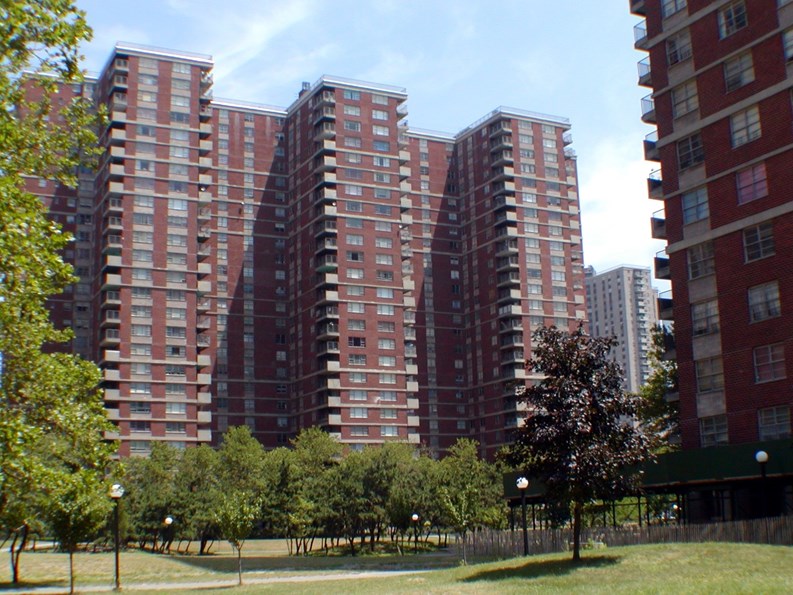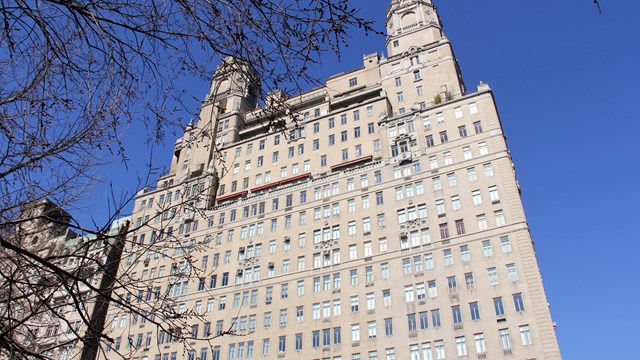With inventory limited, demand high, and prices even higher, the housing market in New York City—and indeed, the whole country—is in a state of crisis. It’s one of the few things lawmakers, activists, and nearly anyone trying to purchase a home in the last few years can agree on. Proposed solutions have included everything from zoning changes allowing more residential development in less-densely populated boroughs to converting office towers left half-empty from the pandemic’s work-from-home exodus into residential units.
Time (and, of course, politics) will tell whether these efforts actually make a dent in the enormous demand for affordable, livable housing in the Big Apple—but this isn’t the first time New Yorkers have had to innovate their way out of a housing crunch. Indeed, while multifamily apartment living existed in other cities prior to their proliferation in the US (including Paris and Berlin in the early 1800s, and even as far back as ancient Rome) the housing co-op model, wherein residents are shareholders in a cooperative corporation, their shares—as opposed to deeds—entitling them to occupy their residence within the building, gained its greatest foothold in NYC in the late 19th century, and has been going strong here ever since, with over 7,000 residential co-ops currently registered with the City.
Cooperative living allowed lower- and middle-income New Yorkers to access good quality, well maintained housing, and the board approval process for prospective buyers allowed them to have a say over who their immediate neighbors were (for better or worse). Let’s take a deeper look at NYC’s co-op tradition, and how it’s evolved over the last 150 years or so.
The Gilded Age
New York City in the late 1800s was in some ways an even more extreme version of socioeconomic divide than it is today. At the time, there were essentially two forms of housing: private homes for the wealthy, which were often extravagant mansions of vast proportions, and tenements for the lower classes, which were often appallingly cramped, cold, dark, and dilapidated, with entire families living and even running businesses out of just one or two windowless rooms. It was in this era that the cooperative housing model came to the Big Apple.
Partners Phillip Hubert and Jared Flagg built The Rembrandt at 152 W. 57th St. as the first apartment building under cooperative ownership in 1881. Inspired by the success of what was known as the “French Flat”—Parisian-inspired apartments that were four times larger than the average tenement and included amenities like steam heat, light, fresh air, and privacy, making them palatable to the middle class—they marketed the units to established artists, academics, and “people of means and good social standing” who themselves financed the development they would eventually call home.
In Hubert’s next co-op endeavor, the iconic Chelsea Hotel (completed in 1885), he brought the idea of hotel amenities to apartment living: a full maintenance staff, dining options, a concierge, and so on. Hubert’s co-ops also introduced the idea of exclusivity; the buildings were controlled by the owners themselves via the co-op board, who could set their own rules and choose who could live there.
Other developers followed Hubert’s successful model, including 34 Gramercy Park, completed in 1883 and today the city’s oldest co-op. At nine stories, the building was one of the first to make use of the newly invented Otis elevator. Although it made possible the idea of “living in the sky,” all units at 34 Gramercy were priced the same (between $10,000 and $20,000), and they each had 10 rooms. This egalitarian framework extended to other novel communal concepts, such as buying commodities like coal and ice in bulk to share building-wide.
A New Century, a New Era
The turn of the new century in 1900 ushered in the next wave of co-op development in New York City—this time in the form of artists’ cooperatives. New York had very few artists’ studios at the time, and those that did exist often left much to be desired in terms of light, space, and accessibility. Developers Henry Ranger and Walter Russell decided to use the cooperative model to finance and build the 67th Street Studio Building, completed in 1903 to the specifications of the artists who would live and work there. It wasn’t long before 67th Street became known as “Artists’ Alley” with the development of more of these cooperative studio apartments—not the one-room studios of today, but more loft-like spaces with 20-foot-plus ceilings, abundant windows, and tons of natural light. Such cooperatives also appealed to the upper classes for whom the arts-adjacent “bohemian” lifestyle was fashionable at the time.
It is also in this era that the first nonprofit workers’ co-ops were established—but they’re probably not the ones you’re thinking of. In 1916, Finnish immigrants built Alku—meaning “beginning”—and Alku Toinen—“Beginning 2”—in Sunset Park, Brooklyn, followed by two dozen more Finnish co-ops in a seven-block radius. These co-ops were based on the “Rochdale Principles”—a doctrine codified in 1844 in the eponymous town in England where the cooperative movement began. The principles have been amended over the years, but as of their last update in 1995, they include “voluntary and open membership; democratic member control; member economic participation; autonomy and independence; education, training, and information in the cooperative enterprise; cooperation among cooperatives; and concern for community.”
After the First World War, New York City’s rent prices skyrocketed. Coupled with nationwide inflation, it made more economic sense for many to own an apartment or home rather than rent one. This led to more speculative building of cooperatives, especially on Park and 5th Avenues, where developers knew that the wealthy would be motivated by these economic factors. Even high-end rental buildings converted to co-op around this time, such as 969 Park Avenue which made the switch in 1911. Co-ops remained the only non-rental multifamily residential model for half a century, until condominiums arrived on the scene in the 1960s.
Postwar Outward Migration
With population growth—and commensurate housing shortages—after World War I, interest in suburban living began to take hold among middle- and upper-middle-class households. Developers met this demand by building large-scale planned communities that blended elements of urban and suburban living. The first of these was Hudson View Gardens co-op in 1923—a collection of “Scarsdale Tudors” in Washington Heights that incorporated light, air, space, and yards into its design.
With the 1913 expansion of the subway, garden apartments, as this style came to be known, were primarily built in the outer boroughs. The entire neighborhood of Jackson Heights was created thusly by the Queensboro Corporation, which advertised the neighborhood on the radio as “the largest community of cooperatively owned garden apartments under single management in the world.” The corporation also made it clear that people of color, Jewish people, Catholics, and dogs were prohibited from entering its grounds.
Partially in response to these discriminatory practices, Governor Al Smith, New York’s first Irish governor, passed the New York State Limited Dividend Housing Companies Act in 1926, which granted 20-year tax abatements and the ability to fund a housing project through collective means such as labor unions, amalgamated banks, and life insurance companies. This led to the spate of limited-equity cooperatives that were primarily the brainchild of Abraham E. Kazan, now known as the “father of cooperative housing in the U.S.”
An immigrant, Lower East Sider, and later head of the Amalgamated Clothing Workers Credit Union, Kazan was appalled by the living and working conditions of working and middle-class New Yorkers, and made it his mission to build adequate, dignified housing that these populations could afford. In total, he built more than 100,000 such homes in New York City, and changed the paradigm for what urban middle-class living could be.
Socialism Meets Capitalism
The original of these cooperators were largely members of the “needle trade” unions—overwhelmingly Jewish immigrants who were steeped in the socialist-leftist ideologies of the Lower East Side labor movement. In 1927, the Amalgamated Clothing Workers of America, backed in part by the famously socialist Jewish Daily Forward newspaper, founded the Amalgamated Housing Cooperative on Van Cortlandt Parkway South in the Bronx. Its design by Springsteen & Goldhammer modeled the “park experience” of the previous planned communities, but with a deliberate utopian, communal way of life that included cooperative schools, press, markets, and more. Today, Amalgamated Housing Cooperative is the oldest co-op still functioning as a limited-dividend co-op.
Each co-op built in this era and in this model had its own social and ideological leftist bent, but even the more explicitly socialist buildings were not necessarily opposed to private funding. John D. Rockefeller, Jr. financed the Thomas Garden Apartments at 840 Grand Concourse in 1927. When the corporation decided to restrict itself to “whites only,” Rockefeller threw his hat (read: wallet) into the Dunbar Apartments in Harlem—a co-op designed by the same architect in the same garden apartment plan, but this time restricted to black residents in an attempt to be “separate but equal.”
Slum Clearance, Title I, and Mitchell-Lama
The Great Depression and then World War II put a damper on new development and left many neighborhoods starving for investment. The federal government stepped in with the Federal Housing Act of 1949, Title I of which allowed for the concept of “urban renewal”—the benevolent-sounding ends to the means of “slum clearance.” Led by the notorious developer Robert Moses, who was not shy about his motivations to quell the tide of white middle-class New Yorkers fleeing to the suburbs, Title I slum clearance was responsible for displacing hundreds if not thousands of predominantly black and brown households.
Through partnership with Kazan, the labor-backed co-ops that sprung up from the razed “slums” provided spacious, light, airy homes for thousands of New York working-class families. Between Co-op Village and later Penn South—the International Ladies Garment Workers Union-sponsored co-op built between 1957 and 1962 with the stated slogan of “self-help and mutual aid”—7,320 new units of dignified housing came to lower Manhattan. The vast majority of their inhabitants were white.
Various attempts were made to create more integrated cooperatives. In 1947, Parkway Village was built in Queens for workers of the United Nations, many of whom were people of color who faced housing discrimination elsewhere. Its original cooperators were still mostly white. Morningside Gardens, developed in 1957 by David Rockefeller with the intention of being integrated, started off 70 percent white. Finally, fed up with such failures, Kazan developed Rochdale Village with the expressed goal of truly integrated housing—but it, too, began with an 80 percent white makeup. Today, however, Rochdale is the largest predominantly black co-op in the country.
In 1955, New York State enacted the Limited Profit Housing Companies Act, better known as Mitchell-Lama, referencing the two state legislators who sponsored the bill. Its purpose was to support the construction of middle-income housing by providing low-interest mortgage loans and real property tax exemptions in exchange for limitation on profits, income limits on tenants, and supervision by the New York State Department of Housing and Community Renewal (DHCR). A total of 269 developments with over 105,000 apartments were built under the program until it was dissolved in the 1970s and placed under the control of the state.
Co-op City & Beyond
By 1968, another Rockefeller—Nelson—was governor of New York, and Kazan was intent on furthering his mission of providing “beauty as well as shelter” to the working classes. Financed under the Mitchell-Lama program, Co-op City in the Baychester section of the Bronx was the apotheosis of Kazan’s ideas. Built on the former site of the Freedomland amusement park, Co-op City became—and still is—the world’s largest co-op development. Its 328 acres are 80 percent open; its 35 buildings house 50,000 residents. Today they are over 60 percent black and over 30 percent hispanic. It is also the largest Naturally Occurring Retirement Community (NORC) in the city, if not the nation, because most original cooperators still live there—a testament to the fact that cooperators are specifically invested in their buildings and communities.
Then came the 1970s, in which “the Bronx was burning” and New York City went bankrupt. Landlords abandoned their apartment buildings, blighting entire neighborhoods and once again decreasing the city’s housing stock. Families fed up with paying high rents for substandard housing saw an opportunity to form their own cooperative communities in these derelict buildings through what became known as urban homesteading. In 1973, the Urban Homesteading Assistance Board was formed and helped convert 1,640 rental buildings to co-op within a year. New York City also passed legislation in 1971 that allowed cooperatives to obtain mortgages, opening the possibility for mutual aid.
The City of New York also acquired many of these abandoned buildings, rehabilitated them under Housing Preservation & Development (HPD), and gave the tenants the opportunity to become shareholders in the limited-equity cooperatives known as Housing Development Fund Corporation cooperatives, or HDFCs. More recently, the City has financed and provided tax exemptions for the new construction, rehabilitation, and stabilization of HDFCs. Today, there are over 1,100 HDFC co-ops—but only a dozen were developed or converted in the last 5-10 years.
By the 1980s and 90s, many of the original limited-equity cooperatives were facing their own confluence of economic factors. The 25-year tax abatements granted to redevelopment companies had expired and were then extended for 10 years during which the taxes were increased in annual increments. Meanwhile, unions had lost their power both in numbers and influence after the 1960s, and many of their once idealist communities had abandoned their socialist tendencies. When the question of privatization hit their doorsteps (literally), there was pressure to go market-rate. All but Penn South elected to become private corporations in a process known as reconstitution, allowing apartment shares to be transferred on the open market for market prices (after some initial years of price caps), but also subjecting the corporations to full real estate taxes that are determined by an opaque system of comparable valuations.
Enter the Bloomberg era and the condo boom of the early 2000s. Residential real estate has skyrocketed, both in price and height. So many of these ultra-tall, ultra-modern condos sit uninhabited, while nearly 80,000 New Yorkers have nowhere to call home. Affordability and availability of housing is but one of the problems; community investment—not just on an economic level, but in the sense of commitment and engagement—is what sustains and nurtures communities and therefore neighborhoods and therefore entire cities. People invested in a cooperative way have demonstrated longevity in those homes and communities, keeping them in New York City and thus letting it remain the thriving, dynamic, diverse, and important city it has been and should always be.







Comments
Leave a Comment